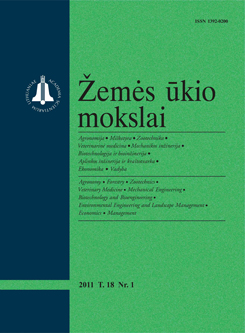Žemės ūkio mokslai / Agricultural Sciences
 ISSN 1392-0200 |
2006 m. Nr. 1.Priedas Lessons learned and challenges in rural development
programmes of Lithuania
A study of Lithuanian rural financial constraints shows that rural development measures like SAPARD and Structural Funds address mainly structural and economic concerns. They primarily assist larger farms and businesses. Being heavily linked to agriculture, rural development measures, as presently selected and designed, do not contribute to reduction of regional disparities. That is, the benefits are focused on Central Lithuania, the more prosperous part of the country. This paper reviews the constraints identified in the study and the challenges that are ahead. Greater progress in achieving broader rural development goals could be reached if more attention is given to factors that have limited the access of some entities to these support programmes. Due to the limited availability of information and / or capacity to draft sound project proposals, these potential participants may be eliminated from the application process. Increased and more effective use of information, training and community support measures and resources of Structural Funds would surely help to narrow regional disparities if there is a concerted effort to
target those participants and regions that have been left behind. These also tend to be the entities and regions that are potentially in greater need of these support measures. Keywords: rural finance, rural development, financial constraints, SAPARD, structural funds |
Numeriai:
2012 - T.19 Nr.1 2011 - T.18 Nr.1, Nr.2, Nr.3, Nr.4 2010 - T.17 Nr.1-2, Nr.3-4 2009 - T.16 Nr.1-2, Nr.3-4 2008 - T.15 Nr.1, Nr.2, Nr.3, Nr.4 2007 - T.14 Nr.1, Nr.2, Nr.3, Nr.4, Nr.Priedas 2006 Nr.1, Nr.1.Priedas, Nr.2, Nr.3, Nr.4 2005 Nr.1, Nr.2, Nr.3, Nr.4 2004 Nr.1, Nr.2, Nr.3, Nr.4 2003 Nr.1, Nr.2, Nr.3, Nr.4 2002 Nr.1, Nr.2, Nr.3, Nr.4 2001 Nr.1, Nr.2, Nr.3, Nr.4 |